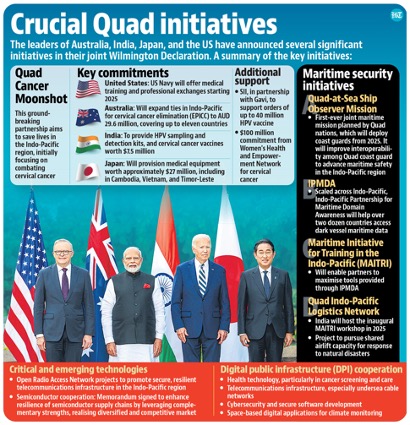China, Iindia and New Delhi’s Quad Dilemma
Relevance: GS 2 – Bilateral, regional and global groupings and agreements involving India and/or affecting India’s interests
Why in the News?
- In September 2024, Prime Minister Narendra Modi visited the United States for a Quad summit involving Australia, India, Japan, and the U.S.
- This meeting is considered the most important Quad meeting to date. The discussions appeared to solidify the Quad as a potential security alliance.
- India faces the delicate task of balancing its relations with China while strengthening ties with Quad partners.
Wilmington Declaration
- The declaration did not explicitly mention any country, including China.
- However, it strongly implied its focus on containing China’s influence in the Indo-Pacific region.
- No formal mutual defense agreement was mentioned in the declaration.
- The clear goal of the “four maritime democracies” (Australia, India, Japan, and the U.S.) was to counterbalance China’s growing power.
State of India-China Ties
Deteriorating Relations
- India-China relations are not just stalled but steadily worsening, particularly in the northern border regions.
- Galwan Stalemate: Despite statements from Indian military and civilian leaders, the border standoff in the Galwan region continues without resolution.
- Increased Vigilance: India has announced it will maintain or increase its border vigilance, deploying more forces even as winter approaches.
- Depsang Plains & Demchok: No breakthrough has been achieved in disengagement talks in these areas, leaving the situation tense.
- Friction Points in Ladakh: The number of friction points has risen, with Indian forces losing access to several key patrolling points they previously controlled.
Augmenting Military Capabilities
- India is boosting its border defenses by deploying new long-range firearms, artillery, howitzers, missiles, rocket systems, and loitering munitions.
- The Indian Army Chief described the situation along the Line of Actual Control (LAC) as “stable yet sensitive,” while affirming that the armed forces are fully prepared for any contingency.
- Caution in Dealing with China: India must remain watchful of China’s responses, as China under Xi Jinping has shown a growing willingness to test its neighbors, including India.
China’s Response
- Despite India’s moves, China appears unfazed, relying on its significantly larger defense budget to counter any Indian initiatives.
- China’s Strategic Posture: China’s historical reliance on surprise tactics remains a concern, and while China seems indifferent to India’s new Western alliances, it is unlikely to ignore them.
Aggressive Nationalism in China
- Careful Diplomacy: India should tread cautiously in its relations with both China and Quad partners. Aligning too closely with nations openly hostile to China could provoke an aggressive response from Xi Jinping’s regime.
- Xi Jinping’s Assertiveness: As early as 2017, Xi Jinping declared that “China under Xi” was different from the Deng Xiaoping era, signaling a more assertive stance.
- CPC Centenary Warning (2021): Xi issued stern warnings to external forces attempting to “bully, oppress, or subjugate” China.
- Increased Nationalism (2022): During the 20th National Congress of the Chinese Communist Party (CPC), leaders expressed a growing and aggressive form of Chinese nationalism.
- Caution in Interpretation: Rationality may not always be expected from China in its actions, and India must be cautious and perceptive in interpreting Chinese intentions.
- Strategic Threats: India’s strategic experts have attempted to differentiate between China’s perception of “real” threats versus peripheral concerns.
- Border Issue: Despite China’s long-standing territorial claims in Ladakh and Arunachal Pradesh, these disputes are not seen as core threats to China’s sovereignty.
- Historical Claims of China: China’s territorial claims stem from non-official maps created during earlier regimes, and even China seems uncertain about their legitimacy, though it is unwilling to relinquish these claims.
- Critical Seaboard Issues: China views its eastern seaboard and territorial claims in the Pacific as existential threats, in contrast to its border disputes with India. Recognizing this difference in China’s perception is crucial for interpreting its actions and priorities.
India’s Strategic Approach
- India’s Nuanced Strategy: Historically, India’s strategic community has understood China’s unpredictable behavior and managed it carefully.
- Recent Shift in India’s Stance: India appears to have adjusted its position in recent years, possibly due to its growing alignment with Western nations, particularly the U.S.
- China’s Overtures: Recent Chinese statements about reducing differences and building consensus on disengaging troops in eastern Ladakh suggest a potential shift in China’s approach.
- India’s Caution: Despite these overtures, India remains cautious and does not seem to fully trust or take China’s moves seriously, likely due to its broader geopolitical concerns.
Beijing’s Perspective on India and the Quad
- Concerns Over Quad Membership: China is increasingly worried about India’s association with the Quad, viewing it as a U.S.-led “coalition of the willing.”
- Threat Perception: In China’s current mindset, India’s membership in the Quad poses a more significant threat than sporadic skirmishes in the Himalayas.
- Wilmington Declaration Impact: The declaration signals a clear defense alliance within the Quad, which China interprets as part of a broader U.S. strategy to encircle and contain it.
- Rising Threat Assessment: China’s perception of India as a threat will likely intensify due to these developments.
- Caution in Messaging: India must be careful not to send mixed signals to avoid serious consequences in its relationship with China.
- Avoiding Confrontational Politics: Engaging in confrontational politics—both in actions and rhetoric—could have negative repercussions for India-China relations.
- Mark Twain’s Wisdom: While history may not repeat itself, past patterns can evoke unease, necessitating caution in India’s approach.
- Rejecting Extreme Views: India should neither embrace Xi Jinping’s concept of a “community of shared future” nor align with the West’s belief that China’s rise is detrimental to global progress.
- Prudent Security Alignment: India should avoid being perceived as aligning its security interests too closely with the U.S. and the West.
- Clarifying Intentions: India is not looking to participate in a coordinated effort against China but must ensure that both China and the global community understand this stance.
- Avoiding Misconceptions: Any impression that India is part of a U.S. strategy to counter China should be avoided, as India’s future should not hinge on opposing China’s ambitions.
Associated articles
Source: The Hindu
Mains Question:
Discuss the implications of India’s increasing alignment with the Quad on its relations with China, considering the historical context, security dynamics, and the need for a balanced diplomatic approach. (250 words)






